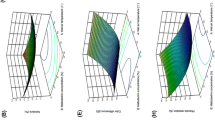Abstract
In this study honey samples of sunflower (Helianthus annus) were botanically characterized. Response surface methodology was used to analyse the effect of temperature, time and pH on the quality responses (hydroxymethylfurfural concentration and diastatic activity) of sunflower honey. A rotatable central-composite design was used to develop models for the responses. Hydroxymethylfurfural concentration was increased with increase in temperature and pH while keeping the other variables constant. Diastatic activity was decreased as the pH moved away from the optimum value of 5.2–5.6. Three-dimensional response surfaces were superimposed, and the regions meeting the diastatic activity calculated as diastase number (9–23.09 °G) and Hydroxymethylfurfural concentration (3–10.21 mg/kg) was identified at 47.5±1 °C for 9.5±1 min at 5.2±0.15 pH. These predicted values for optimum process conditions were in good agreement with experimental data.




Similar content being viewed by others
References
Moore PD, Webb JA (1978) An Illustrated Guide to pollen Analysis. Hodder and Stoughton, London
Ramirez Cervantes MA, Gonzalez Novelo SA, Sauri Duch E (2000) Apicata 35:162–170
Badui DS (1986) Quimica de los alimentos. Ed. Alhambra
Ghoshdastidar N, Chakrabarti J (1992) J Food Sci and Techol 29:399
Kalabova K, Vorlova L, Borkovcova I, Smutna M, Vecerek V (2003) Czech J Animal Sci 48:551–557
Visquert M, Escriche I, Perez-Campos A, Fito P (2004) Alimentaria 352:65–72
Fallico B, Zappala M, Arena E, Verzera A (2004) Food Chem 85:305–313
Codex Alimentarius standard for honey (1999) ref.Nr.CL1993/14-SH FAO and WHO, Rome, 27 p.
United States Department of Agriculture, Fruit and Vegetable Division (1985) United States Standards for grades of Extracted Honey. Fifth issue (p. 8). Washington, DC
Skowronek W, Rybak CH, Szczesna T, Pidek A (1994) Pszczeinicze Zeszyty Naukowe 38:75–79
Babacan S, Pivarnik LF, Rand AG (2002). J Food Sci 67:1625–1630
Thakur S, Saxena DC (2000) Lebensmittel Wiss Technol 33:354–361
Jauregui RNC, Silva MEMP, Areas JAG (2000) J Food Sci 65:1009–1015
Vatsala CN, Saxena DC, Rao PH (2001) Int J Food Sci Technol 36:407–414
Rosell CM, Rojas JA, Debarber CB (2001) Food Hydrocolloids 15:75–81
Singh S, Raina CS, Bawa AS, Saxena DC (2004) Int J Food Sci Technol 39:191–200
Nanda V, Singh S, Raina CS, Jindal N, Singh K, Saxena DC (2004) Eur Food Res Technol 218:529–534
Louveaux J, Maurizio A, Vorwohl G (1978) Bee World 59:139–157
ISI (1994) IS: 4941 Specification of honey. Indian standard Institution, New Delhi
AOAC (1990) In: Helrich K (ed.) Association of official analytical chemists, 15th edn. Arlington, Inc., VA, USA
Hodges D (1974) The pollen loads of the honeybee. Goddards and Cawley Ltd., Hull, N. Humberside, UK
Wodehouse RP (1965) Pollen grains: their structure, identification and signification, in science and medicine. Hafner Publishing Company, NY and London
Hodges D (1952) The pollen loads of the honeybee. International Bee Research Association. UK
Author information
Authors and Affiliations
Corresponding author
Rights and permissions
About this article
Cite this article
Nanda, V., Bera, M.B. & Bakhshi, A.K. Optimization of the process parameters to establish the quality attributes of hydroxymethylfurfural content and diastatic activity of sunflower (Helianthus annus) honey using response surface methodology. Eur Food Res Technol 222, 64–70 (2006). https://doi.org/10.1007/s00217-005-0133-8
Received:
Revised:
Accepted:
Published:
Issue Date:
DOI: https://doi.org/10.1007/s00217-005-0133-8




